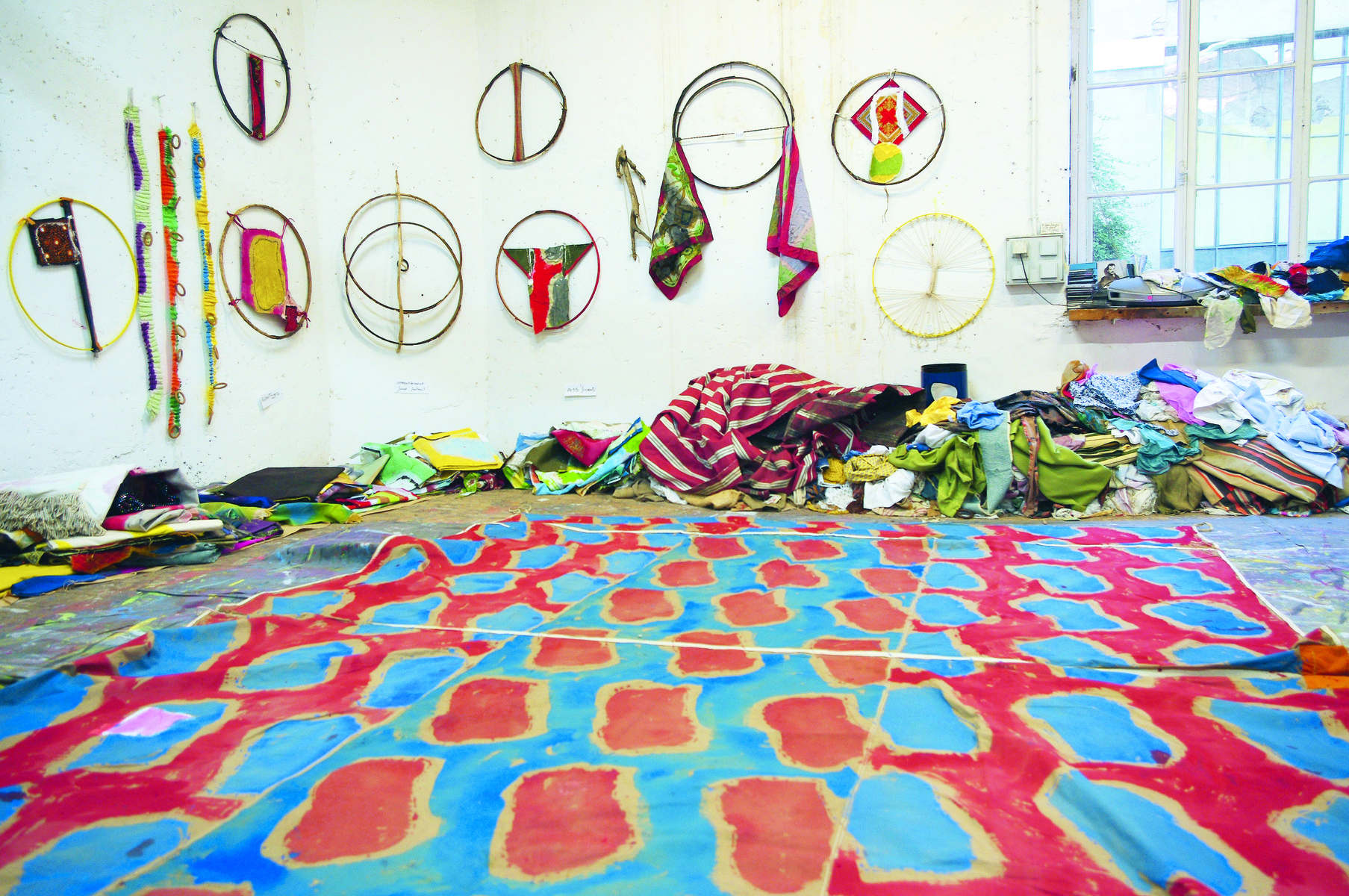Claude Viallat
Cerceaux, Objets, Filets
March 31 - May 28, 2016
Claude Viallat
Cerceaux, Objets, Filets
March 31 - May 28, 2016 The studio is where it all happens for Claude Viallat. Enter. The plank floor creaks under the drips and splashes of paint that spot the plastic drop cloths protecting it. Stacks of folded canvas rest at the foot of the walls; piles of fabric, snips of string, some wooden dowels filched here and there lean on the big bay window revealing the inner courtyard. The walls are hung with spliced wires, chair seats, painted doilies, driftwood, ropes-- coiled or dangling, knotted rags, sprigs and branches. The middle of the room an empty arena, cleared and ready for action.
Early on, Viallat made decisions which set the course for his career. The direction has proven to be historic: his deconstruction of the painting, rejection of the stretcher, fidelity to a single motif. Bernard Ceysson describes that signature mark eschewing any symbolic charge,“a living organism which grows and multiplies as it simultaneously reveals its properties as a unique form and generative matrix.” Its persistence in the heterogeneous plurality of media exploited by Viallat continues to link material and color through five decades of art making. This continuum of motif invokes the handprints that Magdalenian artists transferred on the walls of their rock shelters in the Dordogne.
On the studio walls, wooden elements are held taught by ropes shaping them into bows or fragile hoops. Forsaking the planar dimension of the canvas spread on the floor one enters full volume: savage beauty, a powerful anthropological vision of art. An immanent shamanistic charge reveals itself in these primal materials radiating such flamboyant austerity. Modest components gathered and pieced together so precariously that the assembly could fall apart at any moment, and with it the intimation of Homo faber. No more art or artifact, but a return to a natural order of things. Return to childhood's dawn when there is always a bit of bark to float downstream, a stick to whittle, a rope to lob between two trunks. Viallat would be a mere Robinson Crusoe if he had not eschewed the utilitarian function of materials and reached for their apparent inutility in order to locate their echo, their secret language. Unusable objects chosen for being useless, revealed to the world's gaze but conserving their essential fragility, their limitations. Handmade objects bearing clear traces of their handing. They recover age-old gesture, revive the first artists and their struggle to create. They play out the vestige of the human embodied in primeval tools, whether the bow, the snare, the trap, or the plumb-line, the shim, the knob. Simple objects that inherently call upon the properties of material, exploiting the rigidity of wood and the resilience of string.
Whether wood, rope, mesh or pebbles, these objects manifest time passing, polishing or abrading, patinating or denaturing, giving them the dull and uniform color of this life, after the imbibing and evaporations, exposure to sun, yet preserving the tenacious tactility of wood, that dry and stiff matter. It is an ambivalent sensuality between the distancing of the gaze and the desire to touch. This brings us to the painting: move ahead, that's why we're here. Smooth wood held in place by a palm covered with paint, hoops on which hang shreds of fabric, lace: ah so color returns, adventurous, just where it seemed to have disappeared. Back we are in that colored energy, with Viallat's familiar form, his mark, his language. So too the circle, the frame, but in an ironic and playful fashion, a floating hoop outlined but open, a compromise of a form hesitating freely between the stretcher and the arena. No, we've not abandoned painting. Painting is still there, turning its back, questioning sometimes even called into question by the memory of primal gestures, in the fragile assemblies, fragments of a hypothetical whole, in those object paintings whose simplicity and economy of means testify to the esthetic and ethic of Claude Viallat's work, of the delicate uncouthness which gives him amplitude and ballast.
Bernard Collet
Artist : Claude Viallat
Visitor Information
Ceysson & Bénétière
23 rue du Renard
75004 Paris
Tuesday - Saturday
11am - 7pm
T: + 33 1 42 77 08 22





